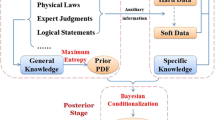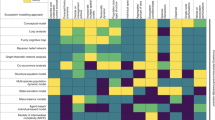Abstract
Model–data fusion is a powerful framework by which to combine models with various data streams (including observations at different spatial or temporal scales), and account for associated uncertainties. The approach can be used to constrain estimates of model states, rate constants, and driver sensitivities. The number of applications of model–data fusion in environmental biology and ecology has been rising steadily, offering insights into both model and data strengths and limitations. For reliable model–data fusion-based results, however, the approach taken must fully account for both model and data uncertainties in a statistically rigorous and transparent manner. Here we review and outline the cornerstones of a rigorous model–data fusion approach, highlighting the importance of properly accounting for uncertainty. We conclude by suggesting a code of best practices, which should serve to guide future efforts.







Similar content being viewed by others
References
Abramowitz G, Pitman A, Gupta H, Kowalczyk E, Wang P (2007) Systematic bias in land surface models. J Hydrometeorol 8:989–1001
Alton P, Bodin P (2010) A comparative study of a multilayer and a productivity (light-use) efficiency land-surface model over different temporal scales. Agric For Meterorol 150:182–195
Baldocchi D (2008) Breathing of the terrestrial biosphere: lessons learned from a global network of carbon dioxide flux measurement systems. Aust J Bot 56:1–26
Barrett DJ, Hill MJ, Hutley LB, Beringer J, Xu JH, Cook GD, Carter JO, Williams RJ (2005) Prospects for improving savanna biophysical models by using multiple-constraints model-data assimilation methods. Aust J Bot 53:689–714
Beven K (2006) A manifesto for the equifinality thesis. J Hydrol 320:18–36
Beven KJ, Smith PJ, Freer JE (2008) So just why would a modeller choose to be incoherent? J Hydrol 354:15–32
Braswell BH, Sacks WJ, Linder E, Schimel DS (2005) Estimating diurnal to annual ecosystem parameters by synthesis of a carbon flux model with eddy covariance net ecosystem exchange observations. Glob Change Biol 11:335–355
Brown JD (2010) Prospects for the open treatment of uncertainty in environmental research. Prog Phys Geogr 34:75–100
Butts MB, Payne JT, Kristensen M, Madsen H (2004) An evaluation of the impact of model structure on hydrological modelling uncertainty for streamflow simulation. J Hydrol 298:242–266
Carbone MS, Vargas R (2008) Automated soil respiration measurements: new information, opportunities and challenges. New Phytol 177:295–297
Carvalhais N, Reichstein M, Seixas J, Collatz GJ, Santos Pereira J et al (2008) Implications of the carbon cycle steady state assumption for biogeochemical modeling performance and inverse parameter retrieval. Glob Biochem Cycles 22:GB2007. doi:10.1029/2007GB003033
Carvalhais N, Reichstein M, Ciasis P, Collatz GJ, Mohecha MD et al (2010) Identification of vegetation and soil carbon pools out of equilibrium in a process model via eddy covariance and biometric constraints. Glob Change Biol 16:2813–2829
Cressie N, Calder CA, Clark JS, Hoef JMV, Wikle CK (2009) Accounting for uncertainty in ecological analysis: the strengths and limitations of hierarchical statistical modeling. Ecol Appl 19:553–570
Desai AR (2010) Climatic and phenological controls on coherent regional interannual variability of carbon dioxide flux in a heterogeneous landscape. J Geophys Res 115:G00J02. doi:10.1029/2010JG001423
Desai AR, Richardson AD, Moffat AM, Kattge J, Hollinger DY et al (2008) Cross-site evaluation of eddy covariance GPP and RE decomposition techniques. Agric For Meteorol 148:821–838
Efron B, Tibshirani RJ (1993) An introduction to the bootstrap. Chapman and Hall, New York
Fox A, Williams M, Richardson AD, Cameron D, Gove JH et al (2009) The REFLEX project: comparing different algorithms and implementations for the inversion of a terrestrial ecosystem model against eddy covariance data. Agric For Meteorol 149:1597–1615
Franks SW, Beven KJ, Quinn PF, Wright IR (1997) On the sensitivity of soil-vegetation-atmosphere transfer (SVAT) schemes: Equifinality and the problem of robust calibration. Agric For Meteorol 86:63–75
Franks SW, Beven KJ, Gash JHC (1999) Multi-objective conditioning of a simple SVAT model. Hydrol Earth Sys Sci 3:488–489
Friedlingstein P et al (2006) Climate-carbon cycle feedback analysis: Results from the C4MIP model intercomparison. J Climatol 19:3337–3353
Hanson PJ, Edwards NT, Garten CT, Andrews JA (2000) Separating root and soil microbial contributions to soil respiration: a review of methods and observations. Biogeochemistry 48:115–146
Hastings WK (1970) Monte-Carlo sampling methods using markov chains and their applications. Biometrika 57:97
Högberg P (2010) Is tree root respiration more sensitive than heterotrophic respiration to changes in soil temperature? New Phytol 188:9–10
Knorr W, Kattge J (2005) Inversion of terrestrial ecosystem model parameter values against eddy covariance measurements by Monte Carlo sampling. Glob Change Biol 11:1333–1351
Kuzyakov Y (2006) Sources of CO2 efflux from soil and review of partitioning methods. Soil Biol Biochem 38:425–448
Lasslop G, Reichstein M, Kattge J, Papale D (2008) Influences of observation errors in eddy flux data on inverse model parameter estimation. Biogeosciences 5:1311–1324
Luo Y, Clark JS, Hobbs T, Lakshmivarahan S, Latimer AM, Ogle K, Schimel D, Zhou X (2008) Symposium 23. Toward ecological forecasting. Bull Ecol Soc Am 89:467–474
Luo Y, Weng E, Wu X, Gao C, Zhou X, Zhang L (2009) Parameter identifiability, constraint, and equifinality in data assimilation with ecosystem models. Ecol Appl 19:571–574
Medvigy D, Wofsy SC, Munger JW, Hollinger DY, Moorcroft PR (2009) Mechanistic scaling of ecosystem function and dynamics in space and time: ecosystem demography model version 2. J Geophys Res 114:G01002. doi:10.1029/2008JG000812
Moore D, Hu J, Sacks WJ, Schimel DS, Monson RK (2008) Estimating transpiration and the sensitivity of carbon uptake to water availability in a subalpine forest using a simple ecosystem process model informed by measured net CO2 and H2O fluxes. Agric For Meteorol 148:1467–1477
Pappenberger F, Beven KJ (2006) Ignorance is bliss: or seven reasons not to use uncertainty analysis. Water Resour Res 42: W05302. doi:10.1029/2005WR004820
Press WH, Teukolsky SA, Vetterling WT, Flannery BP (2007) Numerical recipes: The art of scientific computing. Cambridge University Press, Cambridge
Rastetter EB (2003) The collision of hypotheses: what can be learned from comparisons of ecosystem models? In: Canham CD, Cole JJ, Lauenroth WK (eds) Models in ecosystem science. Princeton University Press, Princeton, pp 221–224
Raupach MR et al (2005) model-data synthesis in terrestrial carbon observation: methods, data requirements and data uncertainty specifications. Glob Change Biol 11:378–397
Reichstein M et al (2003) Inverse modeling of seasonal drought effects on canopy CO2/H2O exchange in three Mediterranean ecosystems. J Geophys Res 108(D23):4726. doi:10.1029/2003JD003430
Richardson AD, Hollinger DY (2005) Statistical modeling of ecosystem respiration using eddy covariance data: maximum likelihood parameter estimation, and Monte Carlo simulation of model and parameter uncertainty, applied to three simple models. Agric For Meteorol 131:191–208
Richardson AD, Braswell BH, Hollinger DY, Burman P, Davidson EA et al (2006) Comparing simple respiration models for eddy flux and dynamic chamber data. Agric For Meteorol 141:219–234
Richardson AD, Mahecha MD, Falge E, Kattge J, Moffat AM et al (2008) Statistical properties of random CO2 flux measurement uncertainty inferred from model residuals. Agric For Meteorol 148:38–50
Richardson A, Williams M, Hollinger DY, Moore DJP, Dail DB et al (2010) Estimating parameters of a forest ecosystem C model with measurements of stocks and fluxes as joint constraints. Oecologia 164:25–40
Sacks WJ, Schimel DS, Monson RK (2007) Coupling between carbon cycling and climate in a high-elevation, subalpine forest: a model-data fusion analysis. Oecologia 151:54–68
Santaren D, Peylin P, Viovy N, Ciais P (2007) Optimizing a process-based ecosystem model with eddy-covariance flux measurements: a pine forest in southern France. Glob Biogeochem Cyc 21:GB2013. doi:10.1029/2006GB002834
Savage K, Davidson EA, Richardson AD (2008) A conceptual and practical approach to data quality and analysis procedures for high-frequency soil respiration measurements. Funct Ecol 22:1000–1007
Taylor JR (1997) An introduction to error analysis: the study of uncertainties in physical measurements. University Science Books, Sausalito
Trudinger CM, Raupach MR, Rayner PJ, Kattge J, Liu Q et al (2007) OptIC project: an intercomparison of optimization techniques for parameter estimation in terrestrial biogeochemical models. J Geophys Res 112:G02027. doi:10.1029/2006JG000367
Vargas R, Carbone M, Reichstein M, Baldocchi D (2011) Frontiers and challenges in soil respiration research: from measurements to model-data integration. Biogeochemistry 102:1–13
Wang YP, Baldocchi D, Leuning R, Falge E, Vesala T (2006) Estimating parameters in a land-surface model by applying nonlinear inversion to eddy covariance flux measurements from eight FLUXNET sites. Glob Change Biol 12:1–19
Wang YP, Trudinger CM, Enting IG (2009) A review of applications of model–data fusion to studies of terrestrial carbon fluxes at different scales. Agric For Meteorol 149:1829–1842
Weng E, Luo Y (2011) Relative information contributions of model vs. data to constraints of short- and long-term forecasts of forest carbon dynamics. Ecol Appl 21:1490–1505
Williams M, Schwarz PA, Law BE, Irvine J, Kurpius MR (2005) An improved analysis of forest carbon dynamics using data assimilation. Glob Change Biol 11:89–105
Williams M, Richardson AD, Reichstein M, Stoy PC, Peylin P et al (2009) Improving land surface models with FLUXNET data. Biogeosciences 6:1341–1359
Wu XW, Luo YQ, Weng ES, White L, Ma Y, Zhou XH (2009) Conditional inversion to estimate parameters from eddy-flux observations. J Plant Ecol 2:55–68
Xie H, Eheart JW, Chen Y, Bailey BA (2009) An approach for improving the sampling efficiency in the Bayesian calibration of computationally expensive simulation models. Water Resour Res 45:W06419. doi:10.1029/2007WR006773
Xu T, White L, Hul D, Luo Y (2006) Probabilistic inversion of a terrestrial ecosystem model: analysis of uncertainty in parameter estimation and model prediction. Glob Biogeochem Cycles 20:GB2007. doi:10.1029/2005GB002468
Zhang Q, Xiao X, Braswell B, Linder E, Baret F, Moore B (2005) Estimating light absorption by chlorophyll, leaf and canopt in a deciduous broadleaf forest using MODIS data and a radiative transfer model. Remote Sens Environ 99:359–371
Zhang L, Luo Y, Yu G, Zhang L (2010) Estimated carbon residence times in three forest ecosystems of eastern China: applications of probabilistic inversion. J Geophys Res 115:G01010. doi:10.1029/2009JG001004
Zhou X et al (2010) Concurrent and lagged impacts of an anomalously warm year on autotrophic and heterotrophic components of soil respiration: a deconvolution analysis. New Phytol 187:184–198
Zobitz JM, Moore D, Sacks WJ, Monson RK, Bowling DR, Schimel DS (2008) Integration of process-based soil respiration models with whole ecosystem CO2 measurements. Ecosystems 11:250–269
Zobitz JM, Desai, AR, Moore DJP, Chadwick MA (2011) A primer for data assimilation with ecological models using markov chain Monte Carlo (MCMC). Oecologia. doi:10.1007/s00442-011-2107-9
Acknowledgments
TFK and ADR acknowledge support from the Northeastern States Research Cooperative, and from the Office of Science (BER), U.S. Department of Energy, through the Terrestrial Carbon Program under Interagency Agreement number DE-AI02-07ER64355, and through the Northeastern Regional Center of the National Institute for Climatic Change Research. MR acknowledges support from the CARBO-Extreme project of the European Commission (FP7-ENV-2008-1-226701). MSC acknowledges support from the Kearney Foundation of Soil Science.
Author information
Authors and Affiliations
Corresponding author
Additional information
Communicated by Russell Monson.
Rights and permissions
About this article
Cite this article
Keenan, T.F., Carbone, M.S., Reichstein, M. et al. The model–data fusion pitfall: assuming certainty in an uncertain world. Oecologia 167, 587–597 (2011). https://doi.org/10.1007/s00442-011-2106-x
Received:
Accepted:
Published:
Issue Date:
DOI: https://doi.org/10.1007/s00442-011-2106-x




